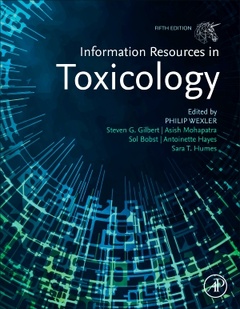Information Resources in Toxicology, Volume 1: Background, Resources, and Tools (5th Ed.) Volume 1: Background, Resources, and Tools
Coordonnateurs : Gilbert Steve, Mohapatra Asish, Bobst Sol, Hayes Antoinette, Humes Sara T.
Rédacteur en Chef : Wexler Philip

Due to the increasing size of the hardcopy publication, the current edition has been divided into two volumes to make it easier to handle and consult. Volume 1: Background, Resources, and Tools, arranged in 5 parts, begins with chapters on the science of toxicology, its history, and informatics framework in Part 1. Part 2 continues with chapters organized by more specific subject such as cancer, clinical toxicology, genetic toxicology, etc. The categorization of chapters by resource format, for example, journals and newsletters, technical reports, organizations constitutes Part 3. Part 4 further considers toxicology?s presence via the Internet, databases, and software tools. Among the miscellaneous topics in the concluding Part 5 are laws and regulations, professional education, grants and funding, and patents. Volume 2: The Global Arena offers contributed chapters focusing on the toxicology contributions of over 40 countries, followed by a glossary of toxicological terms and an appendix of popular quotations related to the field.
The book, offered in both print and electronic formats, is carefully structured, indexed, and cross-referenced to enable users to easily find answers to their questions or serendipitously locate useful knowledge they were not originally aware they needed. Among the many timely topics receiving increased emphasis are disaster preparedness, nanotechnology, -omics, risk assessment, societal implications such as ethics and the precautionary principle, climate change, and children?s environmental health.
Part I. Introduction 1. Toxicology: A Primer 2. History of Toxicology 3. Development of Toxicoinformatics 4. Toxicoinformatics Today 5. Starting Points for Finding Toxicology Resources
Part II. Subject Categorization: Books and More 6. General Texts 7. Analytical Tox 8. Animals in Research 9. Biomarkers 10. Biotechnology 11. Biotoxins 12. Cancer 13. Chemical Compendia 14. Chemicals: Cosmetics and Other Consumer Products 15. Children’s Environmental Health 16. Climate Change 17. Chemicals: Drugs 18. Chemicals: Dusts and Fibers 19. Chemicals: Metals 20. Chemicals: Pesticides 21. Chemicals: Solvents 22. Chemicals: Selected Chemicals 23. Clinical Toxicology 24. Developmental and Reproductive 25. Disaster Preparation & Management 26. Environmental Tox: Aquatic 27. Environmental Tox: Air 28. Environmental Tox: Hazardous Waste 29. Environmental Tox: Terrestrial 30. Environmental Tox: Wildlife 31. Epidemiology 32. Ethical Considerations 33. Exposure Science 34. Food and Nutrient Toxicology 35. Forensic Toxicology 36. Genetic Toxicology 37. Mixtures 38. Molecular, Cell., and Biochem Tox 39. Nanotechnology 40. Noise 41. Occupational Health 42. Omics 43. Pathology 44. Pharmacokinetics and Metabolism 45. Precautionary Principle 46. Radiation 47. Regulatory Tox 48. Risk Assessment 49. Substance Abuse 50. Target Sites: General 51. Target Sites: Cardiovascular 52. Target Sites: Endocrine 53. Target Sites: Gastrointestinal 54. Target Sites: Hematopoietic 55. Target Sites: Immune 56. Target Sites: Kidney 57. Target Sites: Liver 58. Target Sites: Nervous System 59. Target Sites: Respiratory 60. Target Sites: Sensory 61. Target Sites: Skin 62. Terrorism and Warfare (Chemical, Biological and Rad) 63. Testing Methods & Tox Assess (incl Alternatives) 64. Veterinary Tox
Part III. Other Resources 65. Organizations 66. Journals and Newsletters 67. General Interest and Popular Works 68. Technical Reports and Government Information 69. Audiovisual and Non-Print Resources
Part IV. The Online Environment and Data Science 70. The Internet: Recent Trends 71. Web-Based Databases 72. Software Tools for Tox & Risk Assess
Part V. Special Topics 73. Laws and Regulations 74. Hazard Communication 75. Professional Education 76. Public Education 77. Grants and Funding 78. Poison Control Centers 79. Patents
Toxicologists, pharmacologists, drug companies, toxicology testing labs, poison control centers, physicians, legal and regulatory professions (EPA, government), and chemists
Phil recently retired from a long federal career as a Technical Information Specialist at the National Library of Medicine’s (NLM) Toxicology and Environmental Health Information Program, within its Specialized Information Services Division (SIS). His initial position at NLM was as a Fellow of its Associate Program and early work included a brief stint in the Reference Services Section. A recipient of the NLM Regents Award for Scholarly or Technical Achievement and the Distinguished Technical Communication Award of the Washington chapter of the Society for Technical Communication, he was team leader for the development of the ToxLearn online multi-module tutorials, a joint activity with the SOT. Phil had also been project officer for the LactMed file on drugs and lactation, and the IRIS (Integrated Risk Information System) and ITER (International Toxic
- Introductory chapters provide a backdrop to the science of toxicology, its history, the origin and status of toxicoinformatics, and starting points for identifying resources
- Offers an extensive array of chapters organized by subject, each highlighting resources such as journals, databases,organizations, and review articles
- Includes chapters with an emphasis on format such as government reports, general interest publications, blogs, and audiovisuals
- Explores recent internet trends, web-based databases, and software tools in a section on the online environment
- Concludes with a miscellany of special topics such as laws and regulations, chemical hazard communication resources, careers and professional education, K-12 resources, funding, poison control centers, and patents
- Paired with Volume Two, which focuses on global resources, this set offers the most comprehensive compendium of print, digital, and organizational resources in the toxicological sciences with over 120 chapters contributions by experts and leaders in the field
Date de parution : 05-2020
Ouvrage de 1054 p.
21.4x27.6 cm



